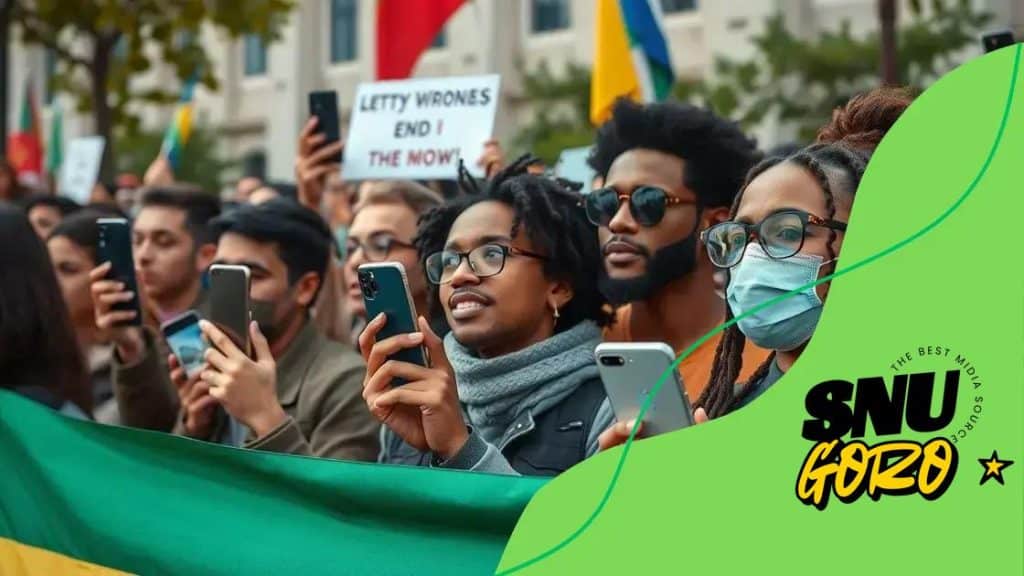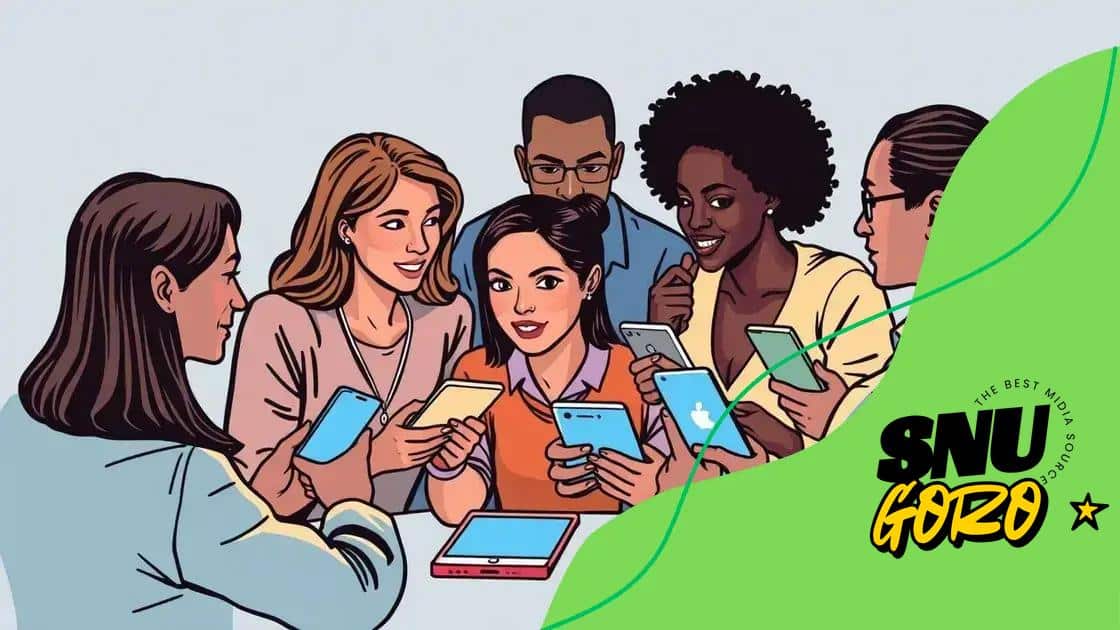The impact of social media on global protests

The impact of social media on global protests is profound, enabling rapid organization, wider engagement, and dynamic messaging, while also presenting challenges such as misinformation and censorship.
The impact of social media on global protests is reshaping how movements emerge and gain traction. Have you ever wondered how a tweet can spark change across the globe? Together, let’s explore this phenomenon.
The role of social media in modern protests
Social media plays a crucial role in shaping modern protests. It acts as a platform for organization and outreach, facilitating quick communication among participants. This instant connection has transformed how movements grow and engage supporters globally.
Instant Communication
One of the largest advantages of social media is its ability to provide instant updates. Protesters can share real-time information about locations, safety, and actions. This helps maintain momentum and allows for quick adjustments to plans as situations change. As people share their experiences, they create a collective narrative that draws in more participants.
Broadening Reach
Social media helps movements reach wider audiences. Through hashtags and shares, messages can spread rapidly beyond local communities. Activists can gain international support through viral posts, amplifying their voices and concerns.
- Examples: Movements like #BlackLivesMatter and #MeToo gained worldwide attention due to social media.
- Community Building: Online platforms help like-minded individuals connect, fostering a sense of belonging.
- Live Streaming: Protesters can document events in real-time, ensuring transparency and accountability.
However, with great power comes great responsibility. While social media helps amplify messages, it can also lead to misinformation. False narratives can spread just as quickly, sometimes undermining important movements. Activists must be vigilant in verifying information and addressing rumors to maintain trust and credibility.
Challenges of Engagement
Social media can sometimes create echo chambers, where users only interact with those who share similar views. This can limit exposure to diverse perspectives and ideas. Additionally, the overwhelming flow of information can lead to fatigue, causing people to disengage from crucial topics they care about.
Ultimately, the role of social media in modern protests is complex. It can empower movements and connect people in impactful ways. Yet it also requires careful navigation to harness its full potential and mitigate risks. By understanding both the advantages and challenges, activists can use these platforms effectively to promote change.
Case studies of social media influencing protests
Examining case studies of social media influencing protests reveals how powerful these platforms can be in mobilizing communities. Various movements around the world have successfully utilized social media to raise awareness and inspire action.
Arab Spring
The Arab Spring serves as a prominent example of social media’s influence. In countries like Tunisia and Egypt, platforms such as Facebook and Twitter were crucial for organizing protests and sharing updates. Activists used these networks to disseminate information quickly, gaining international media coverage. The ability to share live updates helped maintain momentum and encouraged others to join.
2017 Women’s March
Another significant case study is the 2017 Women’s March. Following the election of a controversial figure in the U.S., social media played a pivotal role in rallying millions. The hashtag #WomensMarch spread rapidly, uniting diverse groups advocating for various rights. Organizers relied on social media to mobilize participants, share messages, and coordinate events across the country.
- Online Organizing: The march’s organizers created Facebook events that reached thousands.
- Viral Content: Memes and graphics promoting the event circulated widely, increasing visibility.
- Community Sharing: Participants shared personal stories and experiences, showing the march’s significance to individuals.
Furthermore, the Black Lives Matter movement illustrates how social media can sustain long-term advocacy. After the tragic shooting of Michael Brown in 2014, a hashtag emerged and sparked conversations about systemic racism. This movement has leveraged platforms like Instagram and Twitter for activism, awareness, and mobilization.
Global Reach and Impact
Social media not only amplifies local issues but also connects global audiences. Movements can inspire similar actions in different countries. The George Floyd protests in 2020 reignited discussions about racial injustice worldwide, showing the interconnected nature of these issues. Videos posted online made the conversation a global phenomenon, pushing individuals to reflect and respond.
These case studies demonstrate that social media can significantly influence protests, allowing voices to be heard across borders. The potential for massive mobilization combined with real-time communication creates a powerful tool for change.
How social media shapes public opinion

Social media significantly shapes public opinion by providing platforms for discussion and engagement. As more people turn to social media for news and information, the influence these platforms have on perceptions and beliefs increases. Through likes, shares, and comments, individuals can amplify their voices and impact the views of others.
The Power of Influencers
Influencers play a crucial role in shaping public opinion on social media. They often have dedicated followings, which makes their opinions highly regarded. When influencers speak about social issues, they can sway their audience’s opinion effectively. This is particularly evident in campaigns related to social justice, where influencers share insights and encourage action.
Viral Trends and Movements
Social media provides a space for trends and movements to gain traction quickly. Issues that might have remained local can explode into global discussions. For example, the #MeToo movement gained momentum largely due to shares across various social platforms, allowing people to express their experiences and support.
- Awareness Raising: Campaigns can spread awareness about critical issues within hours.
- Community Building: Like-minded individuals connect and form communities focused on specific causes.
- Changing Narratives: Social media allows for alternative viewpoints to be presented, challenging mainstream narratives.
As conversations grow online, the influence of public opinion can shift dramatically. Individuals often feel empowered to share their views and engage in discussions, which can reshape societal norms. However, this also brings challenges, including the risk of spreading misinformation.
The Role of Algorithms
Algorithms on social media platforms also play an important role in shaping public opinion. They are designed to show users content that aligns with their interests or past behaviors. This can create echo chambers where a user only sees views that reflect their own, potentially limiting exposure to diverse perspectives. As a result, public opinion can become polarized, leading to divisive discussions and misunderstandings.
In conclusion, social media is a powerful tool that shapes public opinion in various ways. From the influence of communities and bloggers to the effect of algorithms creating echo chambers, understanding its dynamics is essential for navigating today’s information-rich landscape.
Challenges of misinformation on social platforms
Misinformation on social media platforms poses significant challenges to activists and the public alike. As individuals share content quickly, the accuracy of the information may not be thoroughly checked. This can lead to confusion and misinterpretation of important issues.
The Spread of False Information
One major issue is how easily false information can go viral. A misleading post can gain traction in minutes, reaching thousands before it is flagged or corrected. Misinformation can alter public opinion and affect the outcomes of protests. As people react to false narratives, the original message of a movement may become lost.
- Speed of Sharing: With just a click, information spreads globally, often faster than fact-checking can occur.
- Emotional Reactions: Misinformation often plays on emotions, making it more shareable.
- Low Barrier to Entry: Anyone can create and post content, regardless of their expertise.
Another concern is the echo chamber effect. Social media algorithms tend to show users content similar to what they previously engaged with. This means that individuals often only see information that reinforces their existing beliefs, making them less open to opposing viewpoints. As a result, misinformation can become entrenched within specific communities.
Consequences for Social Movements
The impact of misinformation extends to social movements as well. When false information circulates, it can distract from the core messages and goals of activism. For instance, if protest organizers are seen as spreading false claims, their credibility can be damaged, and their efforts undermined. This makes it essential for activists to verify information before sharing it.
Moreover, the rapid pace at which misinformation evolves can lead to widespread fear and distrust. Activists must navigate this landscape carefully, working to combat misinformation while still engaging their audience. This often requires proactive communication strategies to clarify misunderstandings and provide accurate information.
In summary, misinformation on social media presents a complex challenge that impacts not only the flow of information but also the effectiveness of activism. Addressing these issues requires collective effort and a commitment to promoting accurate and trustworthy content.
The future of protests in the digital age
The future of protests in the digital age looks promising yet complex. As technology evolves, the ways in which people mobilize for change continue to transform. Social media platforms provide new avenues for organizing and spreading awareness, allowing messages to reach larger audiences than ever before.
Increased Digital Participation
One key aspect of future protests is the potential for increased digital participation. Activists can engage supporters through live streams, virtual meetings, and social media campaigns. This not only allows for greater involvement from people who may be unable to attend physical gatherings, but it also creates a sense of community across vast distances.
Hybrid Protests
Future protests are likely to be hybrid in nature, combining online and offline elements. For example, a protest may involve real-life gatherings complemented by online campaigns that encourage digital activism. This approach allows for a wider reach and shifts the traditional dynamics of how protests are conducted.
- Global Solidarity: Activists from different regions can unite around common causes.
- Safety Measures: Individuals can participate from home, reducing risks associated with physical protests.
- Innovative Fundraising: Online platforms can be utilized for fundraising efforts, helping cover costs related to protests.
Additionally, technology continues to influence how messages are conveyed. Creative content, such as videos, memes, and graphics, can capture attention and promote engagement. These formats resonate well with younger audiences, making the digital space a vital tool for activists.
Challenges Ahead
Despite the possibilities, there are also challenges to consider. The risk of censorship on social media platforms presents a significant hurdle for activists. Furthermore, misinformation can spread rapidly, potentially undermining movements. Protecting the integrity of messages while navigating these challenges will be essential for future activism.
As the digital landscape evolves, so will the strategies for mobilizing protests. Understanding the impact of these changes is crucial for adapting to the future of social movements in a world where technology and activism intertwine.
FAQ – Questions About the Impact of Social Media on Protests
How does social media influence modern protests?
Social media allows activists to organize quickly, share real-time updates, and engage a wider audience, enhancing the reach of their message.
What are some challenges faced by activists using social media?
Activists often confront misinformation, censorship, and the risk of creating echo chambers that limit diverse perspectives.
What role do influencers play in social movements?
Influencers can amplify messages significantly, shaping public opinion and encouraging followers to take action on important social issues.
What is the future of protests in the digital age?
The future is likely to involve hybrid protests, combining both online and offline elements to maximize engagement and participation.





